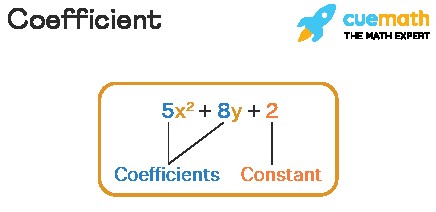In mathematics, the term coefficient is fundamental, especially when dealing with algebraic expressions and polynomials. It represents a constant value that multiplies a variable within a term. Understanding coefficients is crucial for solving equations, simplifying expressions, and grasping more advanced mathematical concepts.
Understanding Coefficients
A coefficient is a number or symbol representing a constant that is multiplied by a variable. This constant can be an integer, a fraction, a decimal, or even a letter representing another constant.
For instance, in the expression ax² + bx + c, ‘x’ is the variable, while ‘a’ and ‘b’ are the coefficients of x² and x, respectively.
The definition of coefficient can be stated as “any number with which we multiply a variable.” For example, in 7.2y, 7.2 is the coefficient of the variable y. It’s important to note that if a variable appears without an explicit number, its coefficient is understood to be 1. For example, in the expression z² + 5, the coefficient of z² is 1.
Coefficients can be positive, negative, real, or imaginary numbers. They can also be represented as decimals or fractions.
Types of Coefficients
While the basic concept of a coefficient is straightforward, there are different types of coefficients that are important to recognize:
-
Coefficient of a Variable: This is the numerical or constant value attached to a specific variable in an expression. In the expression
4p + 7q, 4 is the coefficient ofp, and 7 is the coefficient ofq. -
Numerical Coefficient: This refers specifically to the numerical (constant) part of a coefficient. For example, in the term
6ab, 6 is the numerical coefficient ofab. -
Leading Coefficient: This is the coefficient of the term with the highest degree (highest power of the variable) in a polynomial. To identify it, the polynomial should be written in standard form (terms arranged in descending order of their degrees).
- Example 1: In the expression
9x² - 4x + 2, the leading coefficient is 9. - Example 2: In
5y - 2y³ + 1, the leading coefficient is -2 (after rearranging the terms to-2y³ + 5y + 1). - Example 3: In
10 - 7z⁴ + 3z, the leading coefficient is -7.
- Example 1: In the expression
Finding Coefficients
To find the coefficient of a variable within a term, follow these steps:
- Identify the Variable: Determine the specific variable for which you want to find the coefficient.
- Isolate the Term: Locate the term that includes the variable.
- Identify the Multiplier: The coefficient is the number or expression that is multiplying the variable in that term.
For example, let’s find the coefficients of a and b in the term 8ab:
- To find the coefficient of
a, consider everything else excepta, which is8b. So, the coefficient ofais8b. - Similarly, the coefficient of
bin the term8abis8a.
Another example to clarify this concept: Consider the expression 9x² + 3y - 5.
- In the term
9x²,x²is the variable, and therefore, the coefficient is 9. - In the term
3y,yis the variable, so the coefficient is 3. - The term -5 is known as a constant, not a coefficient, because it does not multiply any variable.
Practical Examples of Coefficients
Let’s look at some examples to solidify our understanding:
-
Example 1: In the expression
kx² + mx + n, what is the coefficient of the termx²?Solution: In the term
kx²,xis the variable.Answer: Therefore, the coefficient is
k. -
Example 2: Identify the numerical coefficients in the algebraic expression:
7x² - 5y + 9.Solution: In the given expression, there are three terms: In the term
7x², the numerical coefficient is 7. In-5ythe coefficient is -5, and 9 is a constant.Answer: Therefore, the numerical coefficients are 7 and -5.
-
Example 3: Identify the coefficients in the expression:
x³ + 4x + 6.Solution: In the above expression, there are three terms. In the term
x³, the coefficient is 1. In4x, it is 4, and 6 is a constant.Answer: Therefore, the coefficients are 1 and 4.
Important Considerations
- A coefficient is always associated with a variable.
- If a variable stands alone without a number, its coefficient is assumed to be 1.
- A coefficient cannot be zero. Multiplying a variable by zero results in zero, effectively eliminating the term.
Conclusion
Understanding What Is Coefficient is essential for success in algebra and beyond. By grasping the definition, different types, and methods for identifying coefficients, you can confidently tackle mathematical problems and build a solid foundation for more advanced topics. Whether you are a student or a lifelong learner, mastering the concept of coefficients will undoubtedly enhance your mathematical skills and understanding.
Frequently Asked Questions (FAQs)
What is a Coefficient Meaning in Math?
A coefficient is a number or an alphabet that is multiplied by a variable of a single term or the terms of a polynomial. For example, in the term 3x, 3 is the coefficient. The coefficient of x in the term 6xy is 6y.
How do you Find the Coefficient?
To find the coefficient, we can cover the variable and look for numbers or alphabets present with it. For example, to find the coefficient of p in the term 4pq, we can hide p, and then we are left with 4q which is the required coefficient.
Can a Coefficient be Negative?
Yes, a coefficient can be negative as well. For example, in the term -2x, -2 is the coefficient.
Can a Fraction be a Coefficient?
Yes, a fraction can also be a coefficient. For example, in the expression: (1/2)x + 5, 1/2 is a fraction which is the coefficient of x.
What is the Coefficient of 0?
The coefficient of 0 is 0 itself as 0 can be written as 0 times some variable, say, 0x. Then the coefficient of x in 0x is 0.
Can a Coefficient be Zero?
A coefficient cannot be zero because when we multiply 0 (as a coefficient) with any variable, the value of the term results in 0. However, a coefficient can be any natural number, negative number, decimals, or fraction.
What is a Numerical Coefficient in Math?
The term numerical coefficient is used for the multipliers of the variable which are in the form of real numbers. A common example is 7xy. Here, the numerical coefficient of xy, x, or y is 7.
What is a Leading Coefficient?
The leading coefficient is defined as the coefficient of the term with the highest power in a polynomial. For example, in the expression 7 + 2x², 2 is the leading coefficient.
What is the Coefficient of x²?
The coefficient of a variable with no numbers or alphabets attached is always 1. So, the coefficient of x² is 1.
What is the Coefficient of a Constant?
The question “coefficient of a constant” is meaningless as there is no concept of a coefficient if there is no variable.
What is a Coefficient Example?
A coefficient is defined as the numbers or alphabets attached with a variable in a term. For example, the coefficient of x in the term 2x⁴ is 2, the coefficient of q in 5pq is 5p, etc.

